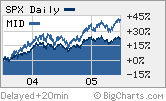 |
| Size doesn't matter: Midcap stocks have outperformed the S&P 500 for the past two years. |
|
|
|
|
|
| * through June 28, 2005 | | Source: Morningstar |
|
|
|
|
NEW YORK (CNN/Money) – Like the middle child in a family, a mid-cap stock is often ignored. Call it the Jan Brady syndrome.
It's a lot easier for investors to either focus on large blue chip companies with names that everybody knows and loves (Marcia, Marcia, Marcia!) or cute, plucky small-cap companies that have explosive growth rates and a lot of potential (Cindy).
But this year, it's Jan's moment to shine. Mid-caps, companies that typically have market values between $2 billion and $10 billion, have been Wall Street champs. The S&P 400 Midcap index is up more than 3 percent year-to-date.
That may not sound like a great return but consider this: the large-cap focused S&P 500 and small-cap heavy Russell 2000 are both in the red this year. And mid-cap focused mutual funds have outperformed their small-cap and large-cap counterparts, according to Morningstar.
So can mid-caps continue to lead?
Oil and consumer fueling midcap surge
A lot of that probably will depend on what happens with oil. With crude oil hovering near $60, energy stocks have been the market's best performing sector this year. And many of the group's biggest gainers are mid-sized firms.
"A lot of energy stocks happen to be mid-caps. And the energy sector is here to stay for awhile," said Neil Hennessy, manager of the Hennessy Focus 30 fund, which exclusively owns midcap stocks.
The fund, which includes oil refiners Valero (Research) and Premcor (Research) and coal company Peabody Energy (Research) among its top five holdings, is up more than 14 percent year to date.
Michael Cuggino, manager of the Permanent Portfolio Agressive Growth fund, also thinks that the energy rally will continue. And his fund has found success thanks to black gold. The fund is up more than 11.5 percent this year and its top holding is oil refiner Frontier Oil (Research).
"Some easy money has been made by people in energy stocks but I don't see anything on the horizon that's going to cause oil to go back to $20 a barrel any time soon since there is a global supply/demand imbalance," Cuggino said.
Energy companies aren't the only winners among mid-caps though. David Scott, co-manager of the Chase Mid Cap Growth fund, said he owns several mid-sized consumer companies and finds them to be better values than larger companies like Wal-Mart (Research) and Coca-Cola (Research), which have struggled this year.
"We're stock pickers. And it turns out that there are more attractive mid-cap consumer oriented stocks than large-caps," said Scott. The fund, which is up nearly 10 percent this year, owns retailers Coach (Research) and Urban Outfitters (Research) and wine maker Constellation Brands (Research).
But investors need to obviously keep an eye on valuations as well. For now, mid-caps still look like they are trading at reasonable prices.
"We've been able to find sufficient mid-cap ideas. We haven't had a problem," said Scott. "But as far as whether mid-caps are still attractive, the bigger issue is value versus growth."
Pay attention to value and growth
The companies in the S&P 400 trade at an average of 20.6 times 2005 earnings estimates and earnings are expected to increase 23 percent this year and 27 percent in 2006, according to data from Thomson/Baseline.
By way of comparison, the companies in the S&P 500 have an average P/E of 20.1, with average earnings growth projections of 22 percent this year and 20 percent next year.
The S&P 600, which consists of small-caps, trades at 26 times earnings forecasts but these smaller companies are expected to grow at a faster clip: 27 percent in 2005 and 35 percent next year.
And of course, it's not a smart idea for investors to stick exclusively with companies of a certain size.
Ron Muhlenkamp, manager of the Muhlenkamp fund, has about 30 percent of his fund's assets in companies that would be considered mid-cap stocks, including Black and Decker (Research), oil driller Patterson-UTI Energy (Research), and homebuilders NVR (Research), Centex (Research) and Toll Brothers (Research).
But that's not by design. "You need to go where the values are," Muhlenkamp said. "We neither know nor care about size. We care what profitability is."
For a look at more of the first half's winners and losers, click here.
For more markets news, click here.

|